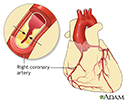Familial lipoprotein lipase deficiency
Type I hyperlipoproteinemia; Familial chylomicronemia; Familial LPL deficiencyFamilial lipoprotein lipase deficiency is a group of rare genetic disorders in which a person lacks a protein needed to break down fat molecules. The disorder causes a large amount of fat to build up in the blood.
Causes
Familial lipoprotein lipase deficiency is caused by a defective gene that is passed down through families.
People with this condition lack an enzyme called lipoprotein lipase. Without this enzyme, the body cannot break down fat from digested food. Fat particles called chylomicrons build up in the blood.
Enzyme
Enzymes are complex proteins that cause a specific chemical change. For example, they can help break down the foods we eat so the body can use them....
Read Article Now Book Mark ArticleRisk factors include a family history of lipoprotein lipase deficiency.
The condition usually first develops during infancy or childhood.
Symptoms
Symptoms may include any of the following:
- Abdominal pain (may appear as colic in infants)
- Loss of appetite
- Nausea, vomiting
- Pain in the muscles and bones
- Enlarged liver and spleen
-
Failure to thrive in infants
Failure to thrive
Failure to thrive refers to children whose current weight or rate of weight gain is much lower than that of other children of similar age and sex....
Read Article Now Book Mark Article - Fatty deposits in the skin (xanthomas)
xanthomas
Xanthoma is a skin condition in which certain fats build up under the surface of the skin.
 ImageRead Article Now Book Mark Article
ImageRead Article Now Book Mark Article - High triglyceride levels in the blood
Triglyceride levels
The triglyceride level is a blood test to measure the amount of triglycerides in your blood. Triglycerides are a type of fat. Your body makes some t...
 ImageRead Article Now Book Mark Article
ImageRead Article Now Book Mark Article - Pale retinas and white-colored blood vessels in the retinas
- Chronic inflammation of the pancreas
- Yellowing of the eyes and skin (jaundice)
Exams and Tests
Your health care provider will perform a physical examination and ask about your symptoms.
Blood tests will be done to check cholesterol and triglyceride levels. Sometimes, a special blood test is done after you are given blood thinners through a vein. This test looks for lipoprotein lipase activity in your blood.
Lipoprotein lipase
Lipase is a protein (enzyme) released by the pancreas into the small intestine. It helps the body absorb fat. This test is used to measure the amou...

Genetic tests may be done.
Treatment
Treatment aims to control the symptoms and blood triglyceride levels with a very low-fat diet. Your provider will likely recommend that you eat no more than 20 grams of fat per day to prevent the symptoms from coming back.
Twenty grams of fat is equal to one of the following:
- Two 8-ounce (240 milliliters) glasses of whole milk
- 4 teaspoons (9.5 grams) of margarine
- 4 ounces (113 grams) serving of meat
The average American diet has a fat content of up to 45% of total calories. Fat-soluble vitamins A, D, E, and K and mineral supplements are recommended for people who eat a very low-fat diet. You may want to discuss your diet needs with your provider and a registered dietitian.
Pancreatitis that is related to lipoprotein lipase deficiency responds to treatments for that disorder.
Support Groups
These resources can provide more information on familial lipoprotein lipase deficiency:
- National Organization for Rare Disorders -- rarediseases.org/rare-diseases/familial-lipoprotein-lipase-deficiency
- NIH Genetics Home Reference -- ghr.nlm.nih.gov/condition/familial-lipoprotein-lipase-deficiency
Outlook (Prognosis)
People with this condition who follow a very low-fat diet can live into adulthood.
Possible Complications
Pancreatitis and recurrent episodes of abdominal pain may develop.
Xanthomas are not usually painful unless they are rubbed a lot.
When to Contact a Medical Professional
Contact your provider for screening if someone in your family has lipoprotein lipase deficiency. Genetic counseling is recommended for anyone with a family history of this disease.
Prevention
There is no known prevention for this rare, inherited disorder. Awareness of risks may allow early detection. Following a very low-fat diet can improve the symptoms of this disease.
References
Genest J, Mora S, Libby P. Lipoprotein disorders and cardiovascular disease. In: Libby P, Bonow RO, Mann DL, Tomaselli GF, Bhatt DL, Solomon SD, eds. Braunwald's Heart Disease: A Textbook of Cardiovascular Medicine. 12th ed. Philadelphia, PA: Elsevier; 2022:chap 27.
Semenkovich CF, Goldberg IJ. Disorders of lipid metabolism. In: Melmed S, Auchus RJ, Goldfine AB, Koenig RJ, Rosen CJ, eds. Williams Textbook of Endocrinology. 14th ed. Philadelphia, PA: Elsevier; 2020:chap 41.
-
Coronary artery disease - illustration
The coronary arteries supply blood to the heart muscle itself. Blood supply through these arteries is critical for the heart. Coronary artery disease usually results from the build-up of fatty material and plaque, a condition called atherosclerosis. As the coronary arteries narrow, the flow of blood to the heart can slow or stop, causing chest pain (stable angina), shortness of breath, heart attack, or other symptoms.
Coronary artery disease
illustration
-
Coronary artery disease - illustration
The coronary arteries supply blood to the heart muscle itself. Blood supply through these arteries is critical for the heart. Coronary artery disease usually results from the build-up of fatty material and plaque, a condition called atherosclerosis. As the coronary arteries narrow, the flow of blood to the heart can slow or stop, causing chest pain (stable angina), shortness of breath, heart attack, or other symptoms.
Coronary artery disease
illustration
-
Cholesterol - InDepth
(In-Depth)
Review Date: 5/12/2023
Reviewed By: Sandeep K. Dhaliwal, MD, board-certified in Diabetes, Endocrinology, and Metabolism, Springfield, VA. Also reviewed by David C. Dugdale, MD, Medical Director, Brenda Conaway, Editorial Director, and the A.D.A.M. Editorial team.



